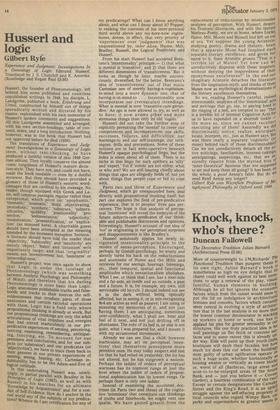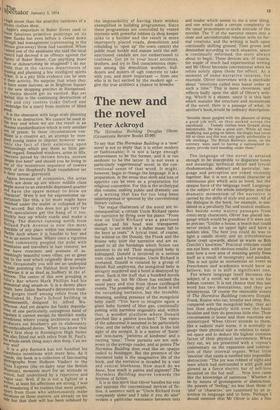Knock, knock, who's there?
Duncan Fallowell
The Decorative Tradition Julian Barnard (Architectural Press £5.00) More of counterweight to J.M.Richards' Pe Functional Tradition than pungent thesis 1.0 its own right, Julian Barnard's book .is nonetheless so high on eye delight that its charm could well work against its best intell' dons: to urge a renewal of the play, visual' fanciful, human elements in build'' Although he all but ignores the econonlic factors which from the outset would seem 0, put the lid on indulgence in architectural bonuses and conceits, factors which certainlY seem central in evolving a style of architecture that in the last analysis is no more that' the lowest common denominator in stacking up workers at home or work, one has applaud his plea for greater sensuality in structures. His one truly practical idea is for wall paintings on flat brick or concrete stir‘ faces and to some extent this is already UP der way. Kids will paint up their youth clubs, boutiques will daub their facades, but hoW much ice does this cut when the buildings most guilty of urban uglification operate 00 such a huge scale, whether horizontally aS housing estates or vertically as tower blocks, or, worst of all (Barbican, large areas arit soon-to-to-be-enlarged areas of the Soutl! Bank, and — just you believe it — coven! Garden), a heartless combination of the two? Except in certain designations like CarnabYt Street and the King's Road, it is an uPtill, struggle against the self-effacing propriety local councils who regard Wimpy Bars, ca.' parks and supermarkets as greater assets 10
a high street than the anarchic rainbows of a Private clothes shop.
Apple's emporium in Baker Street used to boast fabulous primitive paintings on its
tiPper flanks but even before it closed down
through bad management (culminating in the r,arnous give-away) these had vanished. When 'asked one of the assistants she said the local council had decreed it. an offence against the dignity of Baker Street. Can anything more „naive or disheartening be imagined? I do not
u,oubt that in the various departments of 29using and planning a few intelligent spirits 'ticker. It is a pity little evidence can be seen
ef their activity. No surprise that when they, (to have some success, as in Brighton Square sr the new shopping precinct in Hampstead, the media should get so excited. But set a;gainst this is the continuing destruction of vgn and city centres (take Oxford and '-arnbridge for a start) from motives of blind greed, It is the obsession with large scale planning tv„hich is so destructive. We cannot be used in IS way and when we are the result is an irksome standardisation which is only another cq't of prison. In these circumstances vangalism is a creative act, an attempt by ener fised young males to imprint however wan sPnlY the fact of their existence upon Urroundings which pay them so little personal regard. Smashed windows, urine in lifts, concrete pitted by thrown bricks, scream 'People live here!' and should you be living in 11e of the monstrous sequence of towers '.'orth of the Shepherd's Bush roundabout set In their tarmac graveyard. Again because of economics, the areas nich are done up are where middle class Ple move to an erstwhile depressed quarter n have the spare money to blow on enaracter'. Were it not for expressionist op Portunism like this, a lot more might have vanished under the mallet or collapsed of its „,(31v0 accord. But this does not go very far
"en speculators get the hang of it too,
114, ickly buy up whole roads and make a 1411l1ng. The district running north from
Ye'lland Park Avenue is now the most
uesirable of any place within ten minutes of arble Arch where it is feasible to buy and uve in an entire house. Where once a vigorous IniXed community peopled the pubs with Prostitutes and travellers in hair restorer, we ,„tic'sv have crescents and avenues of as
`yrnshingly beautiful town villas; yet at great
cost to the soul which originally drew people t21,ere. Occasionally you will see an underpaid ""-Pair polishing the Habitat door knocker, ,Ptherwise it is as dead as Sudbury in the af?Moon. The centre of this new grouping is itlie's Bar where Mark Phillips had his ?relnarital stag smash-in. It is a dainty place (tr.I,side, here Julian Barnard's decorative tradid'c'n gorges itself among relics from the elnolished St. Paul's School building in nmersmith, designed by Alfred Wa,Trhouse. And yet despite the funky depreda r'''311s of one particularly outrageous band of ,egUlars it cannot escape its identikit media `rencliness where young architects and TV Producers eat blueberry pie in elaborately L're-embroidered denim. When you know that ba's first shop in Kensington High Street ,"Las also fitted out with relics from St. Paul's, '-ne whole swish thing stays skin deep. Can we ever win? It ls a pity Barnard has not handled his ,111anifesto intentions with more brio. As it nds, the book is a collection of fascinating
otographs from Holborn Viaduct to the
zza Express (the ex-dairy near the British 1Useum), memento mori for an attitude in action, half underlined by a repetitive and vague text. Well, if he is not a fighter or a erriter, at least his affections are strong. I was ft Wondering if he realises that most people, laPart from those who unfortunately make ,;e_Fisions on these matters, are already on his but that their will has been subdued by
the impossibility of having their wishes exemplified in building programmes. Since these programmes are controlled by vested interests with powerful lobbies (a shop keeper talks to a builder and the result is more improperly placed roads, demolition and rebuilding to 'open up' the town centre) the public must heckle and expose until the selfsanctioned vandals are too embarrassed to continue. Get ye to your local societies, brothers, and try to find conscientious objectors among the demolition workers, bulldozers and mixers of ugh concrete to take with you; and more important — from one who is in fact excited by the modern age — give the true architect a chance to breathe.



























 Previous page
Previous page